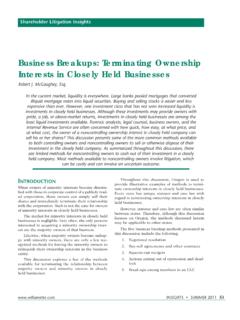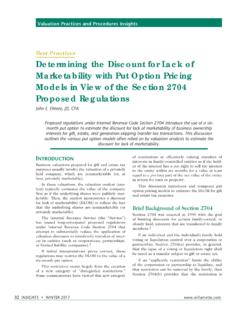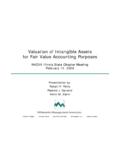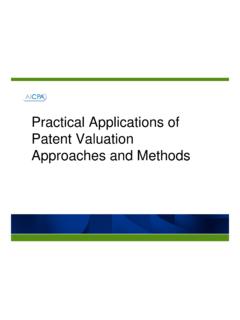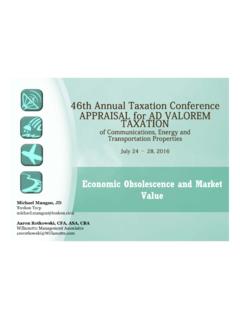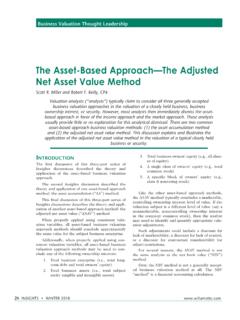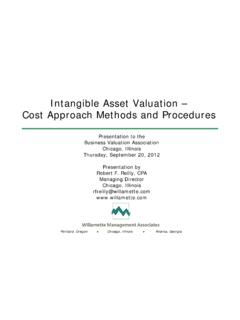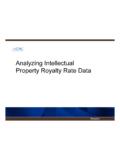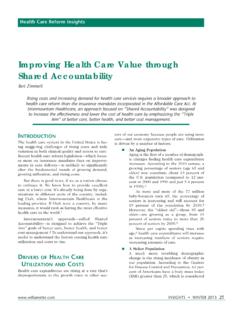Transcription of Quantitative Analysis of Damages in Trade Secrets Litigation
1 Www .willamette .com INSIGHTS SPRING 2016 79A Quantitative Analysis of Damages in Trade Secrets LitigationJohn E. Elmore, JD, CPAF orensic Analysis InsightsTrade Secrets constitute an important component of many companies intellectual property portfolio, and Trade Secrets are an integral driver of economic growth. Yet there is a surprising lack of empirical research related to the valuation of Trade Secrets . The collection of civil case law pertaining to Damages awarded for misappropriation of Trade Secrets offers a potentially rich area of study. This discussion presents a Quantitative Analysis of Damages for Trade Secrets misappropriation in civil Litigation . This Damages Analysis may also provide insights into the Trade Secrets misappropriation of Trade Secrets reflects a significant business risk.
2 Trade Secrets are elements of business that drive investment, innovation, and economic growth. Economists estimate that Trade Secrets comprise roughly two-thirds of the value of companies intellectual property portfolios and reflect a key competitive theft of Trade Secrets can be more problemat-ic for smaller companies due to a greater reliance on a few Trade Secrets . In 2009, a Valspar Corporation employee downloaded proprietary paint formulas from his employer s computer system, which he intended to take to a new employer in company estimated the value of the for-mulas at $20 million, representing an eighth of its entire operating valuation of Trade Secrets is not well studied from an empirical perspective.
3 The collection of civil case law pertaining to the misappropria-tion of Trade Secrets offers a potentially rich area of study. After all, Trade Secrets are validated in a Litigation legal Trade secret status actually exists until a judgement is rendered by the court, unlike other forms of intellectual are based on this validation and reflect an insightful measure of value. Yet Trade Secrets case law remains a largely neglected area of valuation discussion presents a Quantitative analy-sis of Damages for Trade Secrets misappropriation in civil Litigation . And, this discussion includes an overview of Trade Secrets law from a Damages analy-sis studIesUnlike Litigation for patents, trademarks, and copy-rights, Damages in Trade Secrets Litigation is an understudied subject.
4 A review of the published literature revealed three prior studies of case law. None of the studies provided a substantive Analysis of Damages in Trade Secrets civil first study was published in 2006 by John Lerner of Harvard Business In his study, Lerner analyzed a sample of federal court and state court cases in California and Massachusettes involv-ing Trade Secrets determined that the courts found a Trade Secrets violation in two-thirds of the cases. Only 9 percent of the cases recorded an award of Damages (about 50 of the 583 cases considered). In those 80 INSIGHTS SPRING 2016 www .willamette .comcases where Damages were awarded, the average award was $ million in 2004 statistical data was presented in the pub-lished study regarding the range or variability of these Damages .
5 Further, the study presented no discussion of the methodologies employed by the courts to determine these second study was published by Nicola Searle of the University of St. Andrews in The study analyzed 21 cases of criminal Trade Secrets misappropriation based on violation of the Economic Espionage Act of 1996 (EEA).Searle found that the values of misappropriated Trade Secrets ranged from a low of $6,000 to a high of $272 million in 2008 dollars, with a mean of $ million. But the mean reflected a relatively high variability (the standard deviation was times the mean), and Searle noted that 79 percent of the misappropriated Secrets in the study were estimated to be worth less than $5 informative, it is unclear how well this study of criminal trials translates to Damages in civil third study was published in 2010 by Gonzaga Law Review by a team of attorneys from O Melveny & Myers, study analyzed a sample of federal and state court cases: (1) 358 state appellate court cases from 1995 to 2008 and (2) 394 federal court cases from 1950 to 2008.
6 The selected cases all involved Trade Secrets interesting finding of this study was that 78 percent of the state court cases involved alleged employee misappropriators, as compared to only 58 percent of federal court cases (the remainder pertaining mostly to misap-propriation by business partners).While the study provided a number of statistics characterizing the posture and application of law, it presented no statistics or substantive discussion of reason for the dearth of prior stud-ies of Trade Secrets Litigation is the dif-ficulty in compiling and analyzing case data. Neither federal nor state courts systemically track Trade Secrets litiga-tion, so identifying Trade Secrets cases is a challenge.
7 And, for many states, cases are published only at the appellate level. Many state trial decisions, therefore, are not available for present study, as summarized in this discus-sion, comprises a review by the author of federal and state civil court cases involving Damages awards for Trade Secrets misappropriation. The author defined Trade Secrets cases as decisions published from 1950 to 2015 in which a district court or state appellate court decided a substantive issue based on Trade secret civil cases were identified initially as cases in which the term Trade Secrets appeared at least three times based on the keyword search of a com-mercial legal initial search resulted in the identification of 4,738 district court decisions and 1,629 state appellate decisions for the 1950 to 2015 A subsequent winnowing process reduced the number of decisions by selecting only those mentioning a derivation of the terms Damages or award.
8 This winnowing process resulted in 717 district court decisions and 426 state appellate deci-sions that were potentially relevant to the Damages author then compiled two sample popula-tions. The two sample populations were compiled using a computer algorithm that randomly selected 25 percent of the decisions from each group of potentially relevant federal and state court random selection produced a federal sample population of 180 federal court decisions and a state sample population of 104 state appellate court .willamette .com INSIGHTS SPRING 2016 81 The author read every case in the two sample populations and coded them based on multiple criteria. The author excluded decisions from the sample pop-ulations that failed to present an opinion of Damages for each case at hand, includ-ing an amount of review produced a federal sample population of 42 cases and a state sample population of 42 cases.
9 The author then performed a Quantitative Analysis based on the sample populations. The findings of this Analysis are discussed Secrets deFI Trade secret law protects secret, valuable business information from theft and Trade secret generally consists of information that conveys a competitive advantage to its holder so long as the information is kept secret by reasonable measures. Whether information qualifies as a Trade secret under federal or state law is a question of fact for the federal court described Trade Secrets as follows:A Trade secret is really just a piece of information (such as a customer list, or a method of production, or a secret formula for a soft drink) that the holder tries to keep secret by executing confidentiality agreements with employees and others and by hiding the information from outsiders by means of fences, safes, encryption, and other means of concealment, so that the only way the secret can be unmasked is by a breach of contract or a Secrets tend to lose value once they are no longer secret.
10 The court may enjoin a party from disclosing a Trade secret and award monetary dam-ages to compensate for the loss of Trade secret value in cases of , the holder possesses no legal rights to exclude others from using a Trade secret that has been obtained in good faith, such as by reverse engineering or independent discovery. This circum-stance is unique to Trade , trademarks, and copyrights, on the con-trary, convey the right of exclusive use and other legal protection in exchange for public Secrets can coexist with patents, Trade -marks, and copyrights. For example, a Trade secret may be based on information related to the use of an issued patent or published patent application that is not disclosed in the patent specification.
